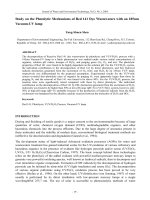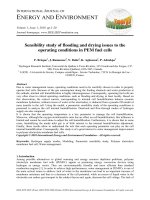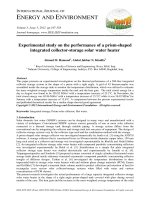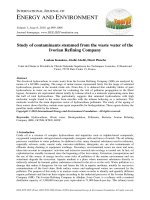Theoretical study of the pressure dependent rate constants of the thermal decomposition of b propiolactone
Bạn đang xem bản rút gọn của tài liệu. Xem và tải ngay bản đầy đủ của tài liệu tại đây (374.93 KB, 4 trang )
ORIGINAL ARTICLE
Theoretical study of the pressure dependent rate
constants of the thermal decomposition
of b-propiolactone
Abolfazl Shiroudi
*
, Ehsan Zahedi
Chemistry Department, Shahrood Branch, Islamic Azad University, Shahrood, Iran
Received 24 May 2010; accepted 10 February 2011
Available online 15 February 2011
KEYWORDS
Unimolecular reaction;
Fall-off pressure;
Thermal decomposition;
RRKM
Abstract A theoretical study of the thermal decomposition of b-propiolactone is carried out using
ab initio molecular orbital (MO) methods at the MP2/6-311+G
**
level and Rice–Ramsperger–
Kassel–Marcus (RRKM) theory. The reported experimental results showed that decomposition
of b-propiolactone occurred by three competing homogeneous and first order reactions. For the
three reactions, the calculation was also performed at the MP2/6-311+G
**
level of theory, as well
as by single-point calculations at the B3LYP/6-311+G
**
//MP2/6-311+G
**
, and MP4/
6-311+G
**
//MP2/6-311+G
**
levels of theory. The fall-off pressures for the decomposition in these
reactions are found to be 2.415, 9.423 · 10
À2
and 3.676 · 10
À3
mmHg, respectively.
ª 2011 Production and hosting by Elsevier B.V. on behalf of King Saud University.
1. Introduction
The thermal decarboxylation of b-lactones (2-oxetanones) is a
well-established methodology for the stereo-specific synthesis
of substituted olefins. The reaction is also interesting from
the mechanistic point of view, since it is one of the very few
examples of a [2+2]-cyclo-reversion process taking place with
retention of configuration (Fig. 1)(Moyano et al., 1989).
b-Propiolactone was a small molecule and offered the
opportunity for the following fall-off in unimolecular rate con-
stant with respect to pressure. Moreover, it can be decomposed
by three different ring cleavages (Fig. 2)(James and Welling-
ton, 1969). In pyrolysis studies on b-propiolactone, the activa-
tion energy for reaction 1 has been found to be 191.7 or
180 kJ mol
À1
(Frey and Pidgeon, 1985; James and Wellington,
1969). Considering enthalpy changes, reactions 2 and 3 are
presumed to have much higher activation energies than reac-
tion 1.
The kinetics of the gas-phase thermal decomposition of b-
propiolactone has been experimentally studied by James and
Wellington (1969) and Frey and coworkers (Sugita et al.,
2000; Frey and Watts, 1983). The presented results demon-
strate that the reaction is homogeneous, unimolecular and
obeys a first-order rate law. In particular, the rate coefficient
for the gas-phase decomposition at low pressure to form car-
bon dioxide and ethylene has been determined (Sugita et al.,
2000; Frey and Watts, 1983) and expressed as a function of
temperature by the following Arrhenius-type equation:
*
Corresponding author. Tel.: +98 21 44434072.
E-mail address: (A. Shiroudi).
Peer review under responsibility of King Saud University.
Production and hosting by Elsevier
Arabian Journal of Chemistry (2015) 8, 644–647
King Saud University
Arabian Journal of Chemistry
www.ksu.edu.sa
www.sciencedirect.com
1878-5352 ª 2011 Production and hosting by Elsevier B.V. on behalf of King Saud University.
/>log k
obs
ðs
À1
Þ¼
ð14:86 Æ 0:3ÞÀð180:46 Æ 3:2Þ kJ mol
À1
2:303 RT
The kinetic of thermal decomposition of b-propiolactone has
been studied previously but in this work, the rate constants
and fall-off pressures were computed for the thermal decompo-
sition reactions of b-propiolactone by using high-level ab initio
methods and RRKM theory. Based on the obtained results,
thermal decomposition pathways were compared according
to kinetic and energetic points of view and available experi-
mental data. Finally, using NBO analysis, reasonable insights
about the reaction pathways mechanism were given.
2. Computational details
The ab initio molecular orbital calculations have been per-
formed with the
GAUSSIAN 98 program (Frisch et al., 1998),
implemented on a Pentium-PC computer with 2.4 GHz proces-
sor. Equilibrium geometries and harmonic vibrational frequen-
cies of b-propiolactone molecule and the transition states in
the considered reactions were optimized at the MP2/6-
311+G
**
level of theory. The thermodynamic functions have
been calculated at the same level. The MP2/6-311+G
**
level
of theory has been used for characterization of stationary
points, zero-point vibrational energies (ZPVE) and RRKM
computations. Initial estimates of the geometry of b-propiolac-
tone and related products in each reactions were obtained by
using MMX method in a molecular-mechanics program
PC-MODEL (88.0) (Serena Software, 1991) followed by full min-
imization using semi-empirical calculations which were carried
out using the PM3 method with the MOPAC 6.0 computer
program (Stewart, 1990a, 1990b). The
GAUSSIAN 98 was finally
utilized to perform ab initio calculation at the MP2/6-311+G
**
level of theory in order to obtain the energy minimum and en-
ergy maximum structures and B3LYP/6-311+G
**
//MP2/6-
311+G
**
, and MP4/6-311+G
**
//MP2/6-311+G
**
levels of
theory for single point calculations.
Energy minimum molecular geometries were located by
minimizing the energy, with respect to all geometrical coordi-
nates. The structures of the transition state geometries were
obtained using the optimized geometries of the equilibrium
structures and the procedure of Dewar et al. (keyword SAD-
DLE) (Dewar et al., 1984). For minimum state structures, only
real frequency values and for the transition states, only a single
imaginary frequency value is accepted. All energy-minima and
energy-maxima geometries obtained in the present work are
calculated to have 3N-6 and 3N-7 real vibrational frequencies
(Ermer, 1975; Mclever, 1974).
In order to calculate the unimolecular rate constant on the
basis of the RRKM theory, the critical energy was computed
using ground state and transition state vibrational frequencies,
temperature of the thermal decomposition and E
o
. The se-
lected pressure ranges for the decomposition of b-propiolac-
tone are 10
À12
–10
3
mmHg. The RRKM algorithm and the
Q-Basic package were used to carry out the unimolecular rate
constants and fall off pressure calculations for reactions 1–3 in
the various pressures.
3. Results and discussion
3.1. Energetic parameters
The ZPVE, total electronic (E
el
) energies and total internal
energies at 0 K (E
o
= E
el
+ ZPVE) for reactant and transition
states of reactions 1–3 are summarized in Table 1. MP2/6-
311+G
**
//MP2/6-311+G
**
, B3LYP/6-311+G
**
//MP2/6-
311+G
**
and MP4/6-311+G
**
//MP2/6-311+G
**
results
show that the energy barrier of thermal decomposition in reac-
tion 1 is 49.95, 35.83 and 44.36 kcal mol
À1
, respectively. In
reaction 2, the energy barrier of thermal decomposition is
66.52, 50.89 and 58.48 kcal mol
À1
, respectively. While, in reac-
tion 3, it is 93.44, 77.25 and 81.76 kcal mol
À1
, respectively at
the same calculations. These results reveal that reaction 1
has the lowest energy barrier among the considered reactions.
Clearly reaction 1 has the lowest energy barrier and the result
of this reaction is in good agreement with the computed acti-
vation energy and that obtained by Frey and Pidgeon
(43.11 kcal mol
À1
)(Frey and Pidgeon, 1985). Indeed, this
agreement is achieved at the MP4/6-311+G
**
//MP2/6-
311+G
**
levels of theory. Further improvement in the quality
of the basis set or in the computational level does not result in
a better agreement. Energy profile for thermal decomposition
reactions 1–3 is depicted in Fig. 3.
The changes of thermodynamic functions i.e. Gibbs free
energies (DG
r
), enthalpies (DH
r
), and entropies (DS
r
), enthal-
pies of activation (DH
„
), Gibbs activation free energies
(DG
„
) and activation entropies (DS
„
) of reactions are given
in Table 2. The thermal decomposition of compounds 1–3 is
an endothermic process; DH
„
and DS
„
values are positive.
As can be seen, DS
„
values are relatively small, so that the
calculated DH
„
and DG
„
parameters are close to the DE
o
values.
3.2. RRKM study and thermal rate constants
RRKM calculations have been performed to determine the
rate constants of the unimolecular decomposition reactions
1–3 by using the ab initio calculated harmonic frequencies
and the energy barrier heights. The reaction 1 involves the low-
est activation barrier; therefore, it has the fastest rate over the
whole energy ranges considered. In order to calculate the
unimolecular rate constants on the basis of modern RRKM
theory, several parameters such as temperature, collision diam-
eter, reduce mass and vibrational frequencies of ground state
and transition state structures should be used. The harmonic
vibrational frequencies of b-propiolactone and transition
Figure 2 Three different ring cleavages of b-propiolactone.
Figure 1 Thermal decarboxylation of b-lactones (2-oxetanones).
Theoretical study of the pressure dependent rate constants of the thermal decomposition of b-propiolactone 645
states at the MP2/6-311+G
**
level of theory are presented in
Table 3.
We have also presented the fall-off data for the unimolecu-
lar thermal decomposition of b-propiolactone at 523.15 K and
the pressure range, 10
À12
–10
3
mmHg, respectively, in Fig. 4.
The rate constant of the fastest reaction, reaction 1, ap-
proaches at atmospheric pressure limit about 10
0.38
mmHg
Figure 3 Energy profile for b-propiolactone unimolecular ther-
mal decomposition reactions 1–3.
Table 1 Calculated energies (in hartree) for ground state and transition state structures for thermal decomposition reactions of four-
membered rings: b-propiolactone [oxetane-2-one].
Method Geometry
(GS) (TS1) (TS2) (TS3)
MP2/6-311+G
**
//MP2/6-311+G
**
ZPVE 0.0694 0.0651 0.0638 0.0608
E
el
À265.7104 À265.6265 À265.5988 À265.5529
E
o
À265.6410 À265.5614 À265.5350 À265.4921
DE
o
a
0.0000 (0.0000)
b
0.0796 (49.9497)
b
0.1060 (66.5161)
b
0.1489 (93.4362)
b
B3LYP/6-311+G
**
//MP2/6-311+G
**
ZPVE 0.0694 0.0651 0.0638 0.0608
E
el
À267.2356 À267.1742 À267.1489 À267.1039
E
o
À267.1662 À267.1091 À267.0851 À267.0431
DE
o
a
0.0000 (0.0000)
b
0.0571 (35.8308)
b
0.0811 (50.8911)
b
0.1231 (77.2465)
b
MP4/6-311+G
**
//MP2/6-311+G
**
ZPVE 0.0694 0.0651 0.0638 0.0608
E
el
À266.5541 À266.4791 À266.4553 À266.4152
E
o
À266.4847 À266.414 À266.3915 À266.3544
DE
o
a
0.0000 (0.0000)
b
0.0707 (44.3649)
b
0.0932 (58.4839)
b
0.1303 (81.7645)
b
E
a
(kcal/mol)
c
43.11 – –
a
Relative to the best configuration.
b
Numbers in parenthesis are the corresponding DE values in kcal mol
À1
.
c
Experimental values are given in parenthesis (James and Wellington, 1969).
Table 2 Theoretical activation parameters and change of thermodynamic functions for the three reactions of the thermal
decomposition of b-propiolactone at the MP2/6-311+G
**
level of theory.
Reaction DH
r
(kcal mol
À1
) DS
r
(kcal mol
À1
K
À1
) DG
r
(kcal mol
À1
) DH
„
(kcal mol
À1
) DS
„
(kcal mol
À1
K
À1
) DG
„
(kcal mol
À1
)
R1 À17.761670 0.036649 À28.677874 41.553084 0.002611 40.774972
R2 27.696408 0.044721 14.363076 54.765307 0.003024 53.864203
R3 À2.692017 0.041791 À15.151856 82.927956 0.005843 81.186616
Table 3 The calculated harmonic vibrational frequencies (in
cm
À1
) at the MP2/6-311+G
**
level of theory for the thermal
decomposition reactions of b-propiolactone.
States Geometry
(GS) (TS1) (TS2) (TS3)
1 163.8436 À1039.3274 À655.5682 À992.1818
2 499.6887 105.0030 173.1409 102.4405
3 518.5293 323.3872 227.7582 132.3231
4 753.3876 459.3902 357.0684 384.0039
5 809.4455 565.3825 470.6599 438.7145
6 910.7025 659.4909 627.1011 531.7378
7 968.2425 779.9780 722.1626 572.6190
8 1039.5582 839.5812 869.4198 768.8294
9 1064.5471 931.4578 890.6937 980.5825
10 1114.2314 1000.7532 1013.7005 1017.9513
11 1180.4820 1066.0180 1086.3011 1031.1339
12 1213.7873 1200.9404 1186.0083 1230.0656
13 1230.8474 1253.4061 1239.7614 1289.4975
14 1367.6988 1325.3584 1419.2081 1349.0152
15 1476.6096 1485.7128 1472.6945 1456.7215
16 1546.0812 1581.7495 1605.2539 1526.1187
17 1901.0079 1994.2972 2126.5492 2058.4005
18 3134.9825 3190.8998 3012.2454 2380.7898
19 3140.2356 3198.9206 3081.1217 3050.3459
20 3203.5321 3287.4598 3126.9494 3135.7020
21 3217.9141 3310.1744 3295.4099 3258.0571
646 A. Shiroudi, E. Zahedi
(P
1/2
= 2.415 mmHg). For reaction 1, the rate constant, k
1
,
can be represented as k
1
= 1.1 · 10
14
exp(À82.82/T)s
À1
, while
k
2
for reaction 2 is 1.35 · 10
14
exp(À111.65/T)s
À1
and k
3
for
reaction 3 is 5.61 · 10
14
exp(À156.16/T) s
À1
. The Arrhenius
factors, A,ink
1
, k
2
and k
3
are almost of the same order.
The exponential factors of k
2
and k
3
are much lower than that
of k
1
, which means the activation energies in reactions 2 and 3
are much higher than that of reaction 1. This indicates
again that k
1
is much higher than k
2
and k
3
and that the
decomposition of the b-propiolactone molecule is dominated
by reaction 1.
In the neighborhood of atmospheric pressures within the
lower stratospheric region it is readily seen that the rates of
all three reactions are well outside the fall-off region. The pres-
sure in which k
1
is reduced to k
1
/2 is determined using the ob-
tained fall-off pressure curve. The fall-off pressures for the
decomposition of b-propiolactone are found to be 2.415,
9.423 · 10
À2
and 3.676 · 10
À3
mmHg, respectively. The fall-
off curves of the decomposition of b-propiolactone show that
the decomposition of reaction 1 is faster than reactions 2 and 3
and is in agreement with activation energies. A small fall-off
pressure value indicates that collision between molecules and
their activated forms occur at low pressures; consequently
the reaction would be slow.
4. Conclusion
Theoretical calculations provide a picture from structural and
energetic points of view for three reactions of the thermal
decomposition of b-propiolactone. The results calculated
by MP2/6-311+G
**
//MP2/6-311+G
**
, B3LYP/6-311+G
**
//
MP2/6-311+G
**
and MP4/611+G
**
//MP2/6-311+G
**
levels
showed that the barrier height of reaction 1 is the lowest of
the three reactions. The fall-off curves of the above mentioned
reactions 1–3 have been drawn by calculating the unimolecular
rate constants at the 523.15 K and the pressure range of 10
À12
–
10
3
mmHg and the fall-off pressures are found to be 2.415,
9.423 · 10
À2
and 3.676 · 10
À3
mmHg, for reactions 1–3,
respectively. The obtained small fall-off pressure values indi-
cate that collision between molecules and their activated forms
occur at low pressure; consequently the reaction would be slow.
References
Dewar, M.J.S., Healy, E.F., Stewart, J.J.P., 1984. J. Chem. Soc.,
Faraday Trans. 2 80, 227.
Ermer, O., 1975. Tetrahedron 31, 1849.
Frey, H.M., Pidgeon, I.M., 1985. J. Chem. Soc., Faraday Trans. 1 81,
1087.
Frey, H.M., Watts, H.P., 1983. J. Chem. Soc., Faraday Trans. 1 79,
1659.
Frisch, M.J., Trucks, G.W., Schlegel, H.B., Scuseria, G.E., Robb,
M.A., Cheeseman, J.R., Zakrazewski, V.G., Montgomery, J.A.,
Startmann, R.E., Burant, J.C., Dapprich, S., Millam, J.M.,
Daniels, A.D., Kudin, K.N., Strain, M.C., Farkas, O., Tomasi,
J., Barone, V., Cossi, M., Cammi, R., Mennucci, B., Adamo, C.,
Clifford, S., Ochterski, J., Petersson, G.A., Ayala, P.Y., Cui, Q.,
Morokuma, K., Malik, D.K., Rabuck, A.D., Raghavachar, K.,
Foresman, J.B., Cioslowski, J., Ortiz, J.V., Stefanov, B.B., Liu, G.,
Liashenko, A., Piskorz, P., Komaromi, I., Gomperts, R., Martin,
R.L., Fox, D.J., Keith, T., Al-Laham, M.A., Peng, C.Y., Nanyak-
kara, A., Gonzalez, C., Challacombe, M., Gill, P.M.W., Johnson,
B., Chen, W., Wong, M.W., Andres, J.L., Head-Gordon, M.,
Replogle, E.S., Pople, J.A., 1998.
GAUSSIAN 98 (Revision A.3)
Gaussian Inc., Pittsburgh, PA, USA.
James, T.L., Wellington, C.A., 1969. J. Am. Chem. Soc. 91, 7743.
James, T.L., Wellington, C.A., 1969. J. Am. Chem. Soc. 91, 1969.
Mclever Jr., J.W., 1974. Acc. Chem. Res. 7, 72.
Moyano, A., Pericas, M., Valenti, E., 1989. J. Org. Chem. 54, 573.
PC-Model, Serena Software, 1991. Box 3076, Bloomington, IN 47402-
3076, USA.
Stewart, J.J.P., 1990a. J. Comput. Aided Mol. Des. 4, 1.
Stewart, J.J.P., 1990b. QCPE 581, Department of Chemistry, Indiana
University, Bloomington, IN, USA.
Sugita, K., Miyamoto, Y., Arai, S., Kuribayashi, S., Majima, T.,
Yamamoto, S., 2000. J. Phys. Chem. A. 104, 2587.
-30
-28
-26
-24
-22
-20
-18
-16
-14
-12
-10
-8
-6
-4
-2
-12.0 -10.0 -8.0 -6.0 -4.0 -2.0 0.0 2.0 4.0
log P (mmHg)
log k
uni
(sec
-1
)
R1 R2 R3
P
1/2
=3.676×10
-3
mmHg
P
1/2
=2.415 mmHg
P
1/2
=9.423×10
-2
mmHg
Figure 4 Fall-off pressure curve of the rate constants for
reactions 1–3 at the 523.15 K.
Theoretical study of the pressure dependent rate constants of the thermal decomposition of b-propiolactone 647









